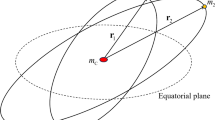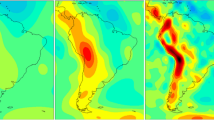Summary
The three Spacelab D-1 Scientist Astronauts were exposed to a 11/2 h 3 g centrifuge run in the supine position, resulting in a linear 3 g acceleration in the x-direction. They used their space experience to evaluate their readapting to normal gravity and compared their observations with ‘Space Adaptation Syndrome’. After the centrifuge runs, the vestibular visual system appeared to be modified in a very specific and reproducible manner. Readapting to the normal 1 g environment took at least 6 h. During this period there was a striking similarity to the astronaut's experience during adaptation to weightlessness in space. A series of vestibular tests were then performed, confirming these subjective findings.
Similar content being viewed by others
References
Baumgarten RJ von (1986) European vestibular experiments on the Spacelab-1 mission. Exp Brain Res 64:239–246
Baumgarten RJ von, Brenske A, Kass JR, Thuember R, Vogel H, Wetzig J (1986) European experiments on the vestibular system during the Spacelab D-1 mission. Proc Symposium, Norderney
Bles W, Bos JE, Furrer R, Graaf B de, Hosman RJ AS W, Kortschot HW, Krol JR, Kuipers A, Marcus JT, Messerschmid E, Ockels WJ, Oosterveld WJ, Smit J, Wertheim AH, Wientjes CJE (1989) Space adaptation syndrome induced by a long duration 3 g centrifuge run. Internal Report IZT-TNO, M10
Grabiel A, Wood CD, Miller II EF, Cramer DB (1968) Diagnostic criteria for grading the severity for motion sickness. Aerosp Med 39:453–455
Homick JL, Reschke MF, Vanderploeg JM (1984) Motion sickness, mechanisms, prediction, prevention and treatment. AGARDograph 372: 36-1-6
Oman CM, Young LR, Watt DG, Money KB, Lichtenberg BK, Kenyon RV, Arrott AP (1988) MIT/Canadian spacelab experiments on vestibular adaptation and space motion sickness. In: Hwang, Daunton, Wilson (eds) Basic and applied aspects of vestibular function. Hong Kong University Press, Hong Kong, pp 183–192
Reschke MF, Homick JL, Ryan P, Moseley EC (1984) Motion sickness, mechanisms, prediction and treatment. AGARDograph 372: 26-1-19
Author information
Authors and Affiliations
Rights and permissions
About this article
Cite this article
Ockels, W.J., Furrer, R. & Messerschmid, E. Simulation of space adaptation syndrome on earth. Exp Brain Res 79, 661–663 (1990). https://doi.org/10.1007/BF00229334
Received:
Accepted:
Issue Date:
DOI: https://doi.org/10.1007/BF00229334




